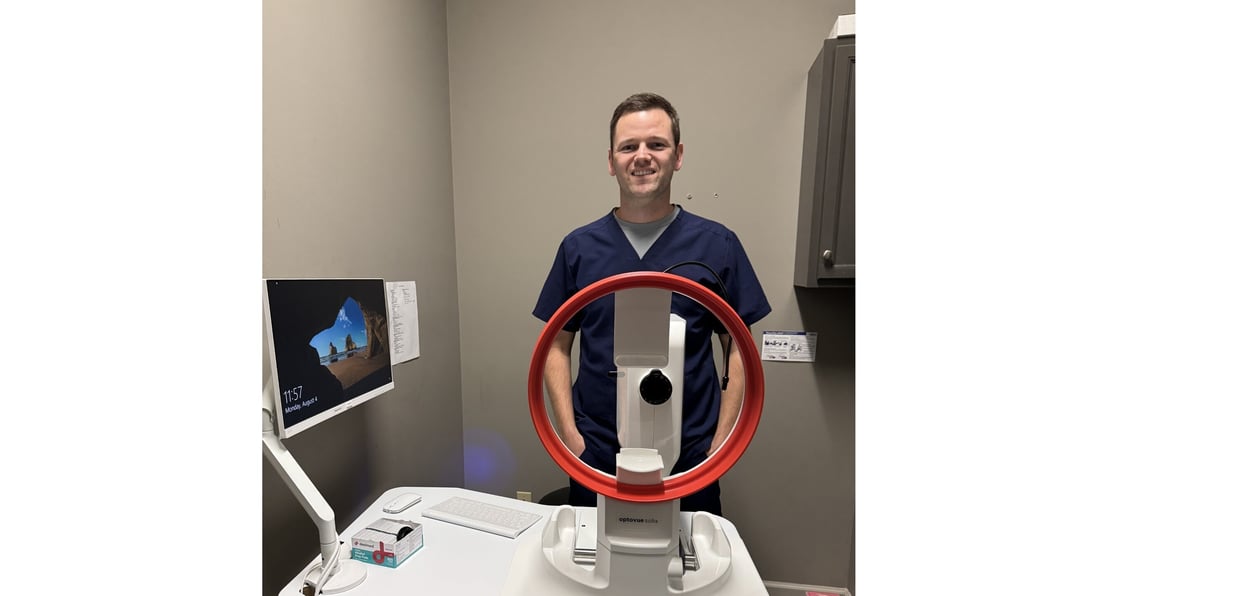The Technology That Helped Grow our Practice From $1.6M to $2.7M—Without Working Weekends
In this article, Dr. Robert Phyfer describes how integrating Visionix technology—including advanced OCT imaging and digital refractors—helped his rural Mississippi eye clinic nearly double its revenue from $1.6M to $2.7M without expanding clinic hours or working weekends.

When I first came to our rural Mississippi clinic in 2019, we were generating around $1.6 million a year as a two-doctor practice.
Back then, I didn’t fully grasp how adding to and upgrading the Visionix technology investments made before my arrival would shape everything about how we care for our patients—and run our business.
Fast forward to today: We just added a third doctor and, thanks in part to Visionix technology, were able to achieve $2.7 in annual revenues with just two doctors up until now.
We’re now almost a $3 million clinic, with three doctors and a team of eighteen support staff. Most days, we see close to 70 patients—yet we still only work Monday through Friday, 8 a.m. to 5 p.m.
I genuinely believe that the integration of Visionix solutions has been at the heart of that transformation.
Visionix Practice Technology Across the Clinic: Why It Matters
Our clinic is equipped with a full suite of Visionix instruments: VX 40 lensometers, multiple VX 65 digital refractors, and Visionix-integrated exam screens and tablets in every lane.
We also use the Briot edging system by Visionix and, more recently, added the Optovue Solix OCT-A platform for OCT, OCT-A, and corneal topography.
After a brief period using a replacement lensometer, I realized there was no comparison to the VX 40—it’s more accurate, intuitive for my staff, and frees up time for them to take on other tasks. When you’re managing high volume, those minutes multiply fast. I just ordered two more VX 40s for my work up team.
The Visionix VX 65 has been equally critical for us, letting us work faster and more efficiently by allowing us to access patient chart data while refracting. Back in my manual phoropter days, I’d lose time going from instruments to the computer, but now, information is instantly available and entered with no wasted steps.
Diagnostics and Success Stories
Integrating the Optovue Solix OCT/OCT-A and topography multimodal platform into our daily routines opened up new opportunities for both patient outcomes and business growth. I have countless examples:
- We caught pellucid marginal degeneration in a patient whose astigmatism had been progressing for years, thanks to Solix’s advanced corneal topography, something older systems missed.
- Another patient with a sight-threatening ulcer was able to be fit for scleral lenses because we got accurate readings (even with severe ocular surface disease) with the Solix.
- With the OCT-A module, I discovered a choroidal mass in a patient with sudden vision loss. The resulting diagnosis—ocular melanoma—came quickly and was confirmed by the retinal specialist. The patient is now undergoing a thorough work up for cancer, and early detection may well have saved his life.
The beauty of the Optovue Solix system is that it provides comprehensive anterior and posterior imaging. It enabled us to diagnose glaucoma much sooner by scanning the optic nerve with 120 images, far surpassing the 16 images from our previous OCT. The OCT-A technology allows us to monitor patients for any type of neovascularization of the retina, and we have been able to detect disease much earlier than with our previous OCT. For a region struggling with access to care, the ability to catch disease earlier and confidently keep more patients in-house is a major win.
Practice Technology that Leads to Efficient Clinics, Satisfied Patients
We are known in our area for providing a high-tech, efficient experience that’s unlike anything most of our patients have seen before. Even brand-new patients notice when we use the Visionix tablets—checking their prescription with a few taps—and love how quickly they get in and out.
Our technology not only reduces wait times; it means that I can spend more quality time where it matters most, either solving a tough medical problem or jumping over to our surgical suite to perform a procedure.
Every minute more a patient spends waiting for their appointment to begin, the less likely they are to have the time to browse and make a purchase in the optical. Thanks to our workflow, patients move from check-in to checkout—often in under an hour—so they have more time to shop without feeling rushed. It’s a win-win for patient satisfaction and practice revenue.
Training That Works and Systems That Scale
Visionix equipment stands out for its ease of use and straightforward training. Our interns, new doctor, and optical staff are up and running fast—often in 30 minutes or less. Protocols are easy to set, the interfaces look and feel familiar, and I don’t lose staff time trying to train on complicated systems.
We now also process nearly 80 percent of our glasses jobs in-house using the Briot finishing system by Visionix. It’s made a real impact: our opticians now complete jobs faster, with fewer errors, and we’ll soon be adding another Briot edger to double output without missing a step.
Almost Doubling Revenue and Taking Weekends Off
When I first started, the business wasn’t small—but it wasn’t what it is now. We’ve nearly doubled revenue in five years, grown to three doctors and expanded to five exam lanes, soon to become six. We’re about to add 1,000 square feet just to keep up with patient demand.
And despite all that growth, I still only work four days a week now, spending more time with my young son and wife. My team and I don’t work weekends, and I truly believe that’s proof of the efficiency, smart systems, and trusted technology we committed to from the beginning.
If I could offer one piece of advice to other practice owners, it’s this: Don’t underestimate what Visionix (and smart technology investments generally) can do for your clinic, your community, and your work-life balance.
In the end, the effort to modernize pays off—in better care, happier patients, and sustainable growth you can be proud of.

Dr. Robert Phyfer, originally from West Point, Mississippi, graduated Summa Cum Laude from Mississippi State University in 2012 and earned his Doctorate of Optometry from the Southern College of Optometry in 2016. He completed a residency in Ocular Disease and Primary Care at the VA Hospital in Daytona Beach, Florida, in 2017. Dr. Phyfer is the owner of Brooks Eye Center & Optical in Columbus, Mississippi. Certified in primary eyecare procedures, Dr. Phyfer is passionate about delivering proactive, patient-focused care. To contact him: drphyfer@brookseye.com
This article originally appeared in Review of Optometric Business in Aug. 2025: https://reviewob.com/practice-technology/
**The information provided is for general informational purposes only. It is not intended to replace and should not be considered a substitute for professional medical advice, diagnosis, or treatment. The content is not designed to replace the relationship between a patient and their healthcare provider. Any medical decision should be made in consultation with a qualified healthcare professional who can provide information tailored to your individual situation. Medical procedures, case studies, and practices mentioned in this content may vary depending on regional standards, local regulations, and the discretion of the healthcare provider. What may be considered appropriate and ethical in one country may differ in another. The content may include general references to medical practices, medications, or treatments that are widely accepted in certain regions but may not be universally applicable or approved. It is important to consult a healthcare professional in your jurisdiction to ensure that the information is relevant to your specific situation. The authors, editors, and contributors of this content disclaim any liability for any adverse effects resulting directly or indirectly from the information contained herein. Readers should exercise their own judgment and seek advice from healthcare professionals when necessary. By accessing and using this content, you acknowledge and accept the terms of this disclaimer.
